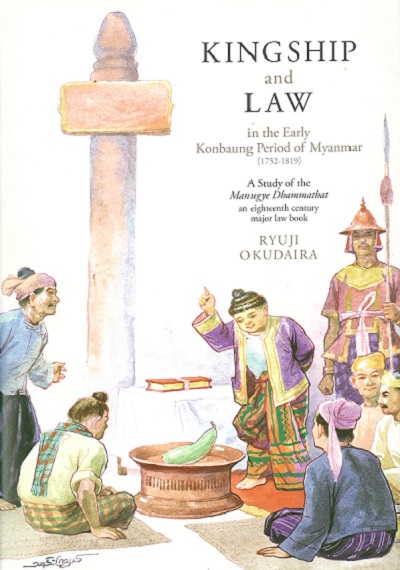Kingship and Law in the Early Konbaung Period of Myanmar(1752-1819)
A Study of the Manugye Dhammathat – an eighteenth century major law book
Ryuji Okudaira
定価8000円+税
B5判変型上製・250ページ
ISBN978-4-8396-0309-0 C3022
【関連書】
【紀伊国屋電子書籍Kinoppy】 Kingship and Law - in the Early Konbaung Period of Myanmar
コンバウン朝前期ミャンマーの王権と法
【Author】
Ryuji Okudaira
【Profile】
Ryuji Okudaira(奥平龍二)
After diplomatic service in the Japanese Ministry of Foreign Affairs from 1965 to 1981, he transferred to the Tokyo University of Foreign studies under the Ministry of Education as an Associate Professor in 1981 and was promoted to the Professorship in 1985. Since retirement from the University in 2002, he has been given the title of Emeritus Professor. His major field of studies is the pre-modern history of Myanmar, legal history and the structure of the ‘Theravāda Buddhist State’. His major publications are (i) Burmese Dhammathat (in) Laws of Southeast Asia (Vol. I) edited by M.B. Hooker (1986), (ii) Biruma Hoseishi Kenkyu Nyumon (“Introduction to the Study of Burmese Legal History”’) in Japanese (2002), and (iii) several theses related to Myanmar political and legal history in the pre-modern period, written in English.
【Foreword】
Myanmar is widely known as Buddhist State in Southeast Asia, together with her eastern neighbours of Thailand, Laos and Cambodia. Since olden days majority of her population were believers of the Sinhalese Buddhism known as Theravada, the common language of which is Pāli. It has long been noticed, however, that Sanskrit tradition was also adopted as seen in the name of Manugye Dhammathat which is nothing but the Burmanized form of Mānava Dharmashastra., although the similarity remains only in the title; its contents having been localized that it has become far from the Sanskritic original.
Despite of a plausible attempt by Dr. David Richardson who translated the Manugye Dhammathat into English as early as 1847, it is regrettable that so little has been done until recently to identify the extent to which the text had played in political culture of the subsequent Burmese kingdoms. The contribution of Professor Okudaira who has an admirable proficiency in Burmese, shall be found in the fact that he laboriously scrutinized different law texts thereby a solid foundation has been laid for the subsequent scholars to deepen their understanding of Buddhist polity of pre-modern Burma, all of which was organized upon the Manugye Dhammathat as its basis for legitimation.
All future researchers who wish to study the history of not only Burma but also those of other Theravada Buddhist countries should be grateful to Professor Okudaira for his valuable contributions he made during the past decades in the field of textual study of the Manugye Dhammathat as seen in the following pages.
Yoneo ISHII
Emeritus Professor of Kyoto University
【Contents】
Forward
Preface
Acknowledgement
Introduction
Part I Myanmar 1752-1819
Chapter I Buddhist Dhamma
Section1. Introduction of the Theravada Buddhism
Section2. Formation and Structure of the Theravada Buddhist State
Section3. Buddhist Theory and Origin of Kingship
Section4. Dhamma in the Structure of the Theravada Buddhist State
Section5. Compilation of the Law Book
Section6. Buddhicisation of Manu’s Tradition
Section7. The Dhammathat in the Theravada Buddhist State
Chapter II The Genres of Myanmar Law Texts
Section1. Dhammathat
Section2. Yazathat
Section3. Hpyathton
Section4. Other Sources
Chapter III Palm-leaf Dhammathats
Section1. The Major Sources of Law
Section2. Locations and Condition of the Dhammathat Source Material
Chapter IV Rise of the Konbaung Dynasty
Section1. The Political Situation of the early Konbaung Dynasty
Section2. External Affairs
Section3. Myanmar Involvement into the English-French Colonial Struggle
Section4. Internal Affairs
Chapter V Konbaung Consecration Ceremonies
Section1. Origin of the Consecration Ceremony
Section2. Theoretical Role of the Muddha-beiktheik Ceremony
Section3. Establishment of King Badon’ s Style of the Muddha-beiktheik Ceremony
Section4. A Step toward the Institutionalization of the Muddha-beiktheik Ceremony
Chapter VI Manugye as the Konbaung Dhammathat
Section1. Compilation of the Manugye Dhammathat under King Alaunghpaya
Section2. Characteristics of the Manugye Dhammathat
ChapterVII The Manugye Dhammathat Becomes the English Dhammathat
Section1. Outline of the History after the Death of King Badon
Section2. Dr. David Richardson
Section3. The Translation of the Manugye Dhammathat by Dr. Richardson
Section4. The Use of the Translation of the Manugye Dhammathat by the British Authority
Section5. King Mindon’s Response: the First Printing Press
Part II Manugye Dhammathat
Chapter VIII Two Different Editions of the Manugye Dhammathat
Section1. The 1760 MS of the Manugye Dhammathat
Section2. The 1782 MS- A Variant of the 1760 MS
Section3. Differences between the 1760 MS and 1782MS
Section4. Insertion of A New Preamble to the Manugye Dhammathat
Chapter IX ‘Duties of Kings and Judges’ (1782MS)
Section1. New Information added to the Manugye Dhammathat (1782 MS)
Section2. Duties of Kingship
Section3. Duties of Judges
Section4. Witnesses
Chapter X Commentary on ‘Duties of Kings and Judges’
Section1. Interpretation of the Preamble to the Manugye Dhammathat
Section2. Implication of the New Chapters of the Manugye Dhammathat (1782MS)
Section3. Changes in the Role of the Dhammathat in the Early Konbaung Period
Chapter XI Early Konbaung ‘Thirty Rulings’ and Some Additional Information of the Manugye Dhammathat (1782MS)
Section1. Thirty Rules added to the Manugye Dhammathat
Section2. Some Additional Information described in the Chapter XVI
Chapter XII Commentary on ‘Early Konbaung Thirty Rulings’ and Some Additionnal Information of the Manugye Dhammathat (1782 MS)
Section1. Insertion of “The Thirty New Rules”
Section2. Addition of Some Information
Part III Kingship and Law in the Early Konbaung Period
Chapter XIII Kingship and Constitution in Eighteenth Century Myanmar
Section1. Framework of the Early Konbaung Polity
Section2. Characteristics of the Konbaung Kingship
Section3. Propagation of the Yaza Dhamma or Royal Obligation
Section4. King Badon’ s Various Reformations
Section5. Conclusion
Chapter XIV Dhammathat and Law in Eighteenth Century Myanmar
Section1. Principles of the Judicial Policy
Section2. Legal Procedure
Section3. Proper Use of the Dhammathats
Section4. Judicial Policy incorporated into the New Chapters of the Manugye Dhammathat
Section5. How the Judges Used the Dhammathats in Court
Section6. Conclusion

